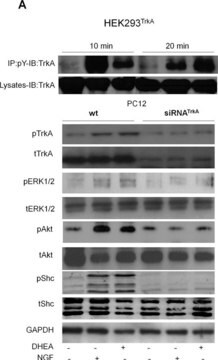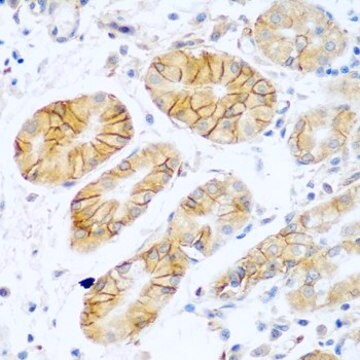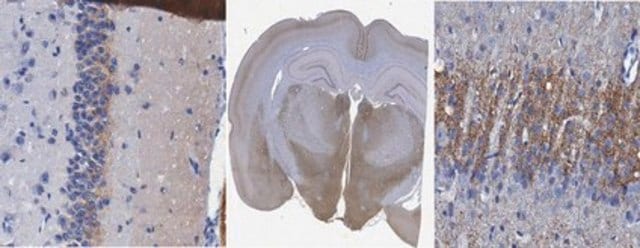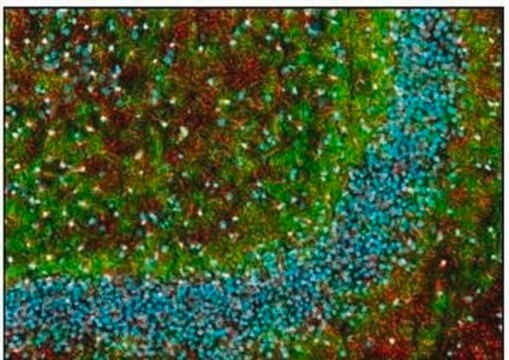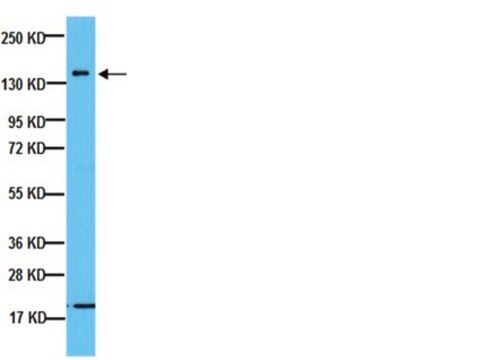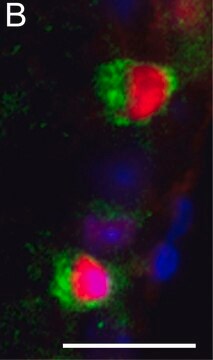MABF959
Anti-CD47 Antibody, clone C5/D5
clone C5/D5, from mouse
Synonim(y):
Leukocyte surface antigen CD47, Antigenic surface determinant protein OA3, CD47, IAP, Integrin-associated protein, Protein MER6
About This Item
Polecane produkty
pochodzenie biologiczne
mouse
Poziom jakości
forma przeciwciała
purified immunoglobulin
rodzaj przeciwciała
primary antibodies
klon
C5/D5, monoclonal
reaktywność gatunkowa
human
metody
flow cytometry: suitable
izotyp
IgG1κ
numer dostępu NCBI
numer dostępu UniProt
Warunki transportu
ambient
docelowa modyfikacja potranslacyjna
unmodified
informacje o genach
human ... CD47(961)
Powiązane kategorie
Opis ogólny
Specyficzność
Immunogen
Zastosowanie
Flow Cytometry Analysis: A representative lot detected the expression of exogenously transfected human CD47 on the surface of CaCO2 cells (Liu, Y., et al. (2001). J. Biol. Chem. 276(43):40156-40166).
Flow Cytometry Analysis: Representative lots detected human polymorphonuclear (PMN) neutrophils surface CD47 immunoreactivity, which was upregulated after fMLP stimulation (Liu, Y., et al. (2001). J. Biol. Chem. 276(43):40156-40166; Parkos, C.A., et al. (1996). J. Cell Biol. 132(3):437-450).
Immunoaffinity Purification: A representative lot was immobilized on resins and employed for affinity purification of CD47 from HT29 (subclone Cl 19.A) lysate (Parkos, C.A., et al. (1996). J. Cell Biol. 132(3):437-450).
Immunocytochemistry Analysis: A representative lot immunostained the basolateral surfaces of methanol-fixed CaCO2 monolayers expressing exogenously transfected human CD47 by fluorescent immunocytochemistry (Liu, Y., et al. (2001). J. Biol. Chem. 276(43):40156-40166).
Immunocytochemistry Analysis: A representative lot immunostained the basolateral membrane of paraformaldehyde-fixed T84 human intestinal epithelial cell monolayer by fluorescent immunocytochemistry (Parkos, C.A., et al. (1996). J. Cell Biol. 132(3):437-450).
Immunofluorescence Analysis: A representative lot immunostained the colonic crypts and lamina propria leukocytes at the basal and lateral, but not apical, aspects of the epithelium in paraformaldehyde-fixed frozen human colon tissue sections by fluorescent immunohistochemistry (Parkos, C.A., et al. (1996). J. Cell Biol. 132(3):437-450).
Immunoprecipitation Analysis: A representative lot immunoprecipitated ~60-65 kDa glycosylated CD47 from T84 human intestinal epithelial cell lysate. Target band size reduced to ~35 kDa following deglycosylation by N glycosidase F treatment (Parkos, C.A., et al. (1996). J. Cell Biol. 132(3):437-450).
Neutralizing Analysis: Representative lots caused a delay of human polymorphonuclear (PMN) neutrophils migration across polarized monolayers of T84 human intestinal epithelial cells in a bidirectional fashion without affecting PMN neutrophils or T84 adhesion. Tyrosine phosphorylation inhibitor genistein prevented delay by clone C5/D5 (Liu, Y., et al. (2001). J. Biol. Chem. 276(43):40156-40166; Parkos, C.A., et al. (1996). J. Cell Biol. 132(3):437-450).
Inflammation & Immunology
Jakość
Flow Cytometry Analysis: 0.4 µL of this antibody detected CD47 surface expression on the gated lymphocytes population among one million human PBMCs.
Opis wartości docelowych
Postać fizyczna
Przechowywanie i stabilność
Handling Recommendations: Upon receipt and prior to removing the cap, centrifuge the vial and gently mix the solution. Aliquot into microcentrifuge tubes and store at -20°C. Avoid repeated freeze/thaw cycles, which may damage IgG and affect product performance.
Inne uwagi
Oświadczenie o zrzeczeniu się odpowiedzialności
Nie możesz znaleźć właściwego produktu?
Wypróbuj nasz Narzędzie selektora produktów.
Kod klasy składowania
12 - Non Combustible Liquids
Klasa zagrożenia wodnego (WGK)
WGK 2
Temperatura zapłonu (°F)
Not applicable
Temperatura zapłonu (°C)
Not applicable
Certyfikaty analizy (CoA)
Poszukaj Certyfikaty analizy (CoA), wpisując numer partii/serii produktów. Numery serii i partii można znaleźć na etykiecie produktu po słowach „seria” lub „partia”.
Masz już ten produkt?
Dokumenty związane z niedawno zakupionymi produktami zostały zamieszczone w Bibliotece dokumentów.
Nasz zespół naukowców ma doświadczenie we wszystkich obszarach badań, w tym w naukach przyrodniczych, materiałoznawstwie, syntezie chemicznej, chromatografii, analityce i wielu innych dziedzinach.
Skontaktuj się z zespołem ds. pomocy technicznej